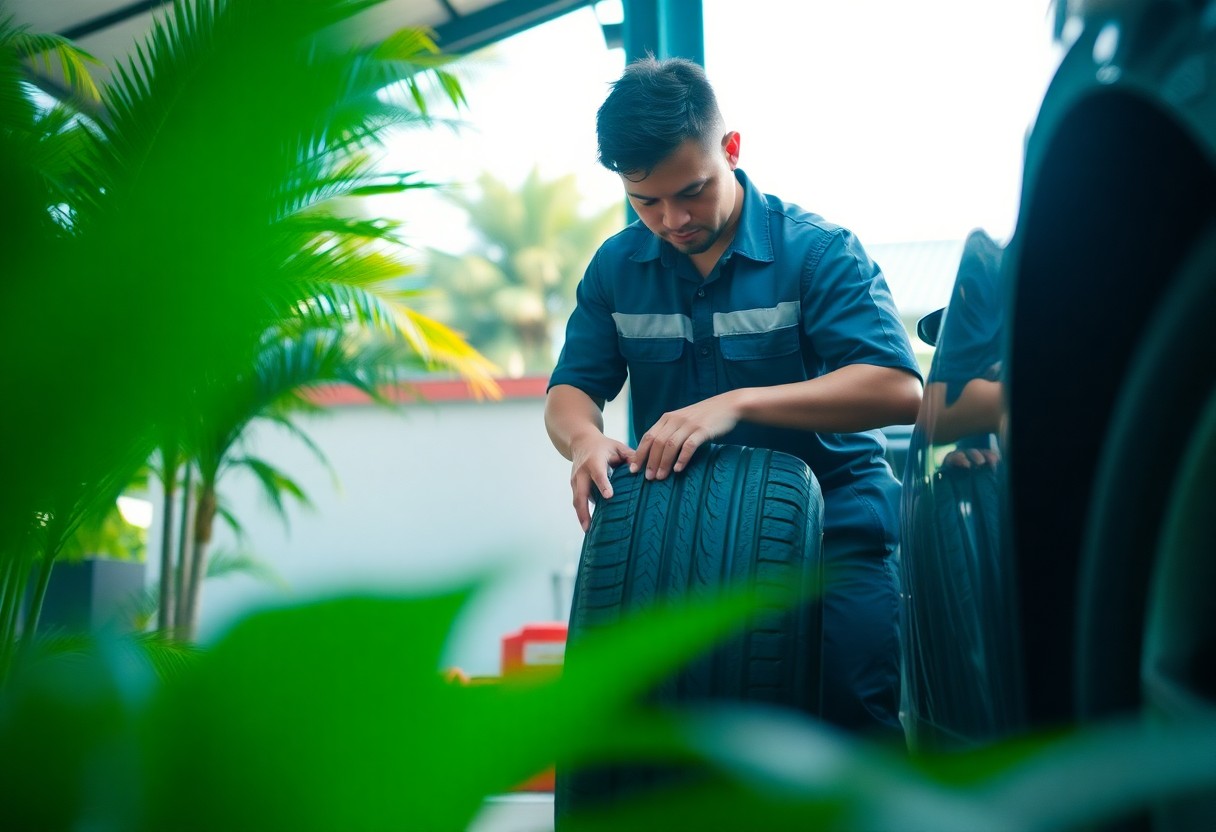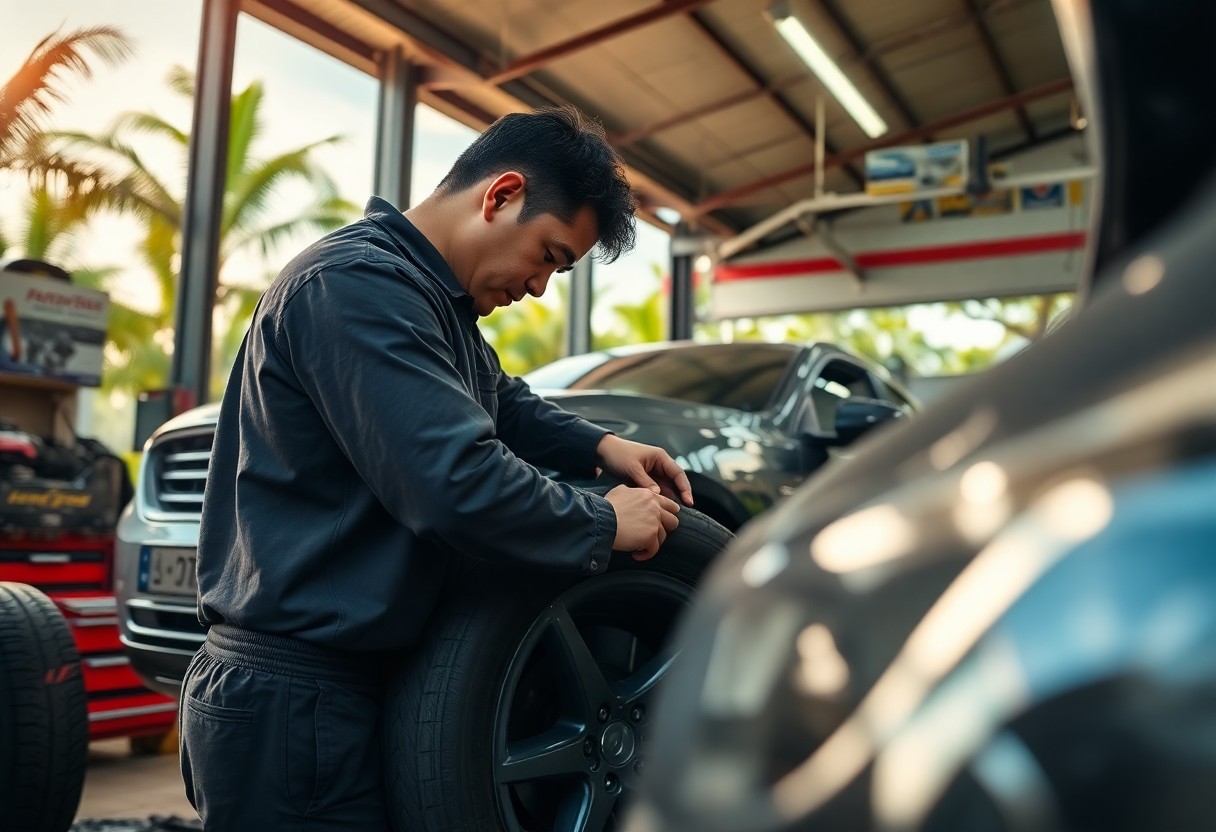You may find yourself wondering how often you should rotate your tyres, especially given Klang’s diverse climate, which can impact their longevity and performance. Regular tyre rotation is imperative for even wear and to maintain effective handling and braking capabilities. In this post, we’ll explore the recommended rotation frequency tailored to Klang’s weather conditions, ensuring you can maximize your tyre life and ensure safe driving throughout the year.

Understanding Tyre Wear
A comprehensive understanding of tyre wear is crucial for maintaining vehicle safety and performance. Tyre wear refers to the gradual degradation of your tyres due to various factors, which can lead to reduced traction, handling issues, and decreased fuel efficiency. Keeping an eye on the tread depth and pattern can help you determine when to replace your tyres and ensure a smoother, safer ride.
Factors Affecting Tyre Wear
With a variety of elements influencing tyre wear, it’s important to be aware of what can impact the longevity of your tyres. Factors include:
- Driving habits (aggressive acceleration and braking)
- Road conditions (potholes, rough surfaces)
- Tyre pressure (underinflated or overinflated)
- Weight load of your vehicle
Assume that you maintain your vehicle properly and regularly check tyre conditions to prevent premature wear.
Importance of Regular Rotation
Rotation of your tyres is crucial to promote even tyre wear and extend their lifespan. By routinely shifting the position of each tyre, you can mitigate the effects of uneven wear caused by factors like front-wheel drive or braking patterns. This practice not only enhances handling and safety but also saves you money in the long run by delaying the need for replacements.
Even if your tyres appear to be wearing evenly, regular rotation prevents any potential issues that may not be immediately visible. Without it, certain tyres may wear down faster than others, leading to compromised performance and increased risk of blowouts. Establishing a regular tyre rotation schedule is a simple yet effective way to ensure your vehicle remains safe and efficient on the road.

The Climate of Klang
Even in Klang, the climate significantly influences your vehicle’s performance and maintenance requirements. With a tropical rainforest climate, the region experiences high humidity and consistent rainfall, particularly during the monsoon seasons. The heat and moisture can affect not only the road conditions but also the life expectancy of your tyres, making it important to pay attention to rotation schedules tailored to your local weather patterns.
Characteristics of Klang’s Climate
One of the defining features of Klang’s climate is its high humidity coupled with warm temperatures throughout the year. The average daily temperature ranges from 24°C to 32°C, providing a consistent warm environment. With regular rainfall, particularly from May to September during the southwest monsoon, these conditions can lead to varying road traction and increased wear on your tyres.
Impact of Weather on Tyre Performance
Beside the obvious changes in traction, the weather in Klang can also affect your tyres’ durability and handling characteristics. Heat can cause rubber compounds in tyres to degrade quicker, while excessive rain increases the risk of hydroplaning, making proper maintenance and rotation important.
Impact on your tyres is significant due to Klang’s climate conditions. The high humidity can lead to faster wear and tear, while the combination of wet and dry roads can reduce traction. In wet conditions, it’s dangerous to have unevenly worn tyres as they can hydroplane and compromise your safety. Regularly rotating your tyres not only promotes even wear but also enhances their overall performance in varying weather situations, allowing you to maintain better control of your vehicle.
Recommended Rotation Frequency
If you want to maintain optimal tyre performance and longevity in Klang’s climate, it is advisable to rotate your tyres every 5,000 to 7,500 kilometers. You can learn more about When should you rotate your tires, and how is it done? This regular schedule helps ensure even wear and enhances your vehicle’s traction and handling during rainy seasons.
General Guidelines
An effective way to determine when to rotate your tyres is to follow your vehicle manufacturer’s recommendation, found in your owner’s manual. Regular checks for uneven wear can also signal when it’s time to rotate. Keeping track of your driving habits and road conditions helps in maintaining your tyres in excellent condition.
Specific Recommendations for Klang
At varying temperatures and humidity common in Klang, you should consider more frequent rotations if you often drive on uneven roads or in heavy rain. These factors contribute to tyre wear, making regular rotations beneficial for your safety and vehicle performance.
Frequency of rotation can also be adjusted based on your specific driving conditions. If you often navigate through potholes or uneven surfaces, you might want to rotate your tyres every 5,000 kilometers to prevent unwanted wear. Additionally, if you commonly drive during the wet season, more frequent rotations will help enhance traction and stability, ensuring a safer driving experience in Klang’s unique climate.

Signs Your Tyres Need Rotation
Now that you understand the importance of tyre rotation, it’s crucial to recognize the signs that indicate your tyres are due for a change. Regularly observing your tyres can help ensure they wear evenly, improving their lifespan and enhancing your vehicle’s performance. Look out for any noticeable differences in tread wear and handling, as these can signal when it’s time to rotate your tyres.
Visual Indicators
At a glance, your tyres can reveal valuable information about their condition. Uneven tread wear, such as more wear on the inside or outside edges of the tyre, is a clear sign that a rotation is necessary. Additionally, if you notice any bulges, cracks, or punctures, it’s vital to consult a professional, as these issues can lead to safety hazards.
Performance Indicators
One of the most significant performance indicators that your tyres need rotation is a noticeable change in handling. If you feel your vehicle pulling to one side or notice vibrations while driving, it might be time to check the tyres. A decrease in traction or an increase in road noise can also signify uneven wear and the need for rotation.
Due to consistent wear patterns, tyres on different positions of your vehicle experience various levels of stress. When front and rear tyres wear unevenly, this can compromise your vehicle’s stability and performance. Keeping an eye on these performance indicators, such as changes in handling and road noise, can help you decide when to rotate your tyres to maintain optimal driving conditions.
Impact of Neglecting Tyre Rotation
Despite the importance of regular tyre rotation, many drivers overlook this maintenance task. Failing to rotate your tyres can lead to uneven wear patterns, significantly reducing their lifespan and performance. This neglect can affect your vehicle’s handling, increase fuel consumption, and compromise your overall driving experience, making it vital to schedule rotation at the recommended intervals.
Safety Risks
Safety should be your top priority when it comes to tyre maintenance. Neglecting tyre rotation can lead to uneven tread wear, which compromises grip and handling. This increases the likelihood of losing control while driving, particularly in adverse weather conditions, putting you and your passengers at risk while on the road.
Cost Implications
On the financial side, ignoring tyre rotation can lead to significant expenses. When tyres wear unevenly, you may have to replace them sooner than necessary, leading to unplanned costs. Additionally, poorly maintained tyres can negatively affect fuel efficiency, resulting in higher fuel expenses over time.
And it’s not just about the immediate costs – investing in regular tyre rotations can save you money in the long run. By extending the lifespan of your tyres, you reduce the frequency of replacements and improve fuel efficiency, leading to better savings. Think of tyre rotation as a preventive measure to maintain the integrity of your vehicle and your wallet.
Additional Tyre Maintenance Tips
Once again, maintaining your tyres goes beyond just rotation. To ensure safety and longevity, consider these additional maintenance tips:
- Regularly inspect for any signs of damage or wear.
- Keep your tyres clean and free from debris.
- Ensure alignment and balancing is done when needed.
- Store your spare tyre properly to avoid deterioration.
After implementing these tips, your tyres will perform better and last longer.
Checking Tyre Pressure
Pressure is vital for safe driving and tyre longevity. Regularly check your tyre pressure at least once a month and before long trips. The ideal pressure level can usually be found in your owner’s manual or on a sticker inside the driver’s door. Always ensure the tyres are cold when checking, as heat can give inaccurate readings.
Tread Depth Monitoring
Along with pressure, monitoring tread depth is key to your safety. Worn tyres can lead to decreased grip, especially on wet roads, increasing your risk of accidents. It’s important to check your tread depth regularly.
But how do you effectively monitor tread depth? Use the penny test: insert a penny into the tread groove with Lincoln’s head facing down. If you can see all of Lincoln’s head, it may be time to replace your tyres. Maintaining adequate tread depth will enhance traction and improve overall vehicle performance, particularly in Klang’s varying weather conditions.
To wrap up
Ultimately, understanding how often to rotate your tyres in Klang’s humid climate is necessary for maintaining your vehicle’s performance and longevity. Aim to rotate your tyres every 5,000 to 8,000 kilometres, or as recommended by your manufacturer. By doing so, you’ll ensure even wear and enhance handling and safety. For more guidance, you can explore How Often Should You Rotate Your Tires in Humid Climates? and enhance your knowledge on proper tyre maintenance.
